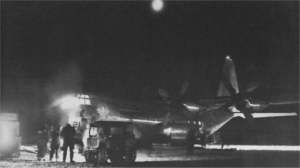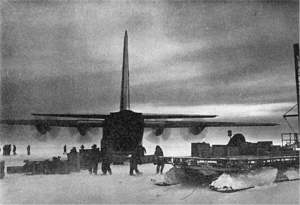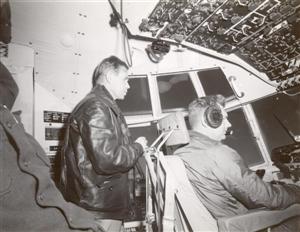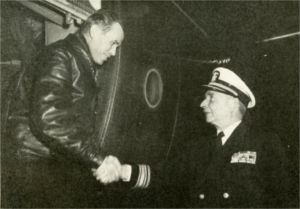THE EVACUATION OF LEONID KUPEROV FROM BYRD STATION. APRIL 1961

The VX-6 aircraft 321, with patient Kuperov on board, attempts a JATO
takeoff from the specially prepared ice runway at McMurdo (Bruce Raymond)
(official photo caption). Actually, this takeoff attempt failed. once the snow was
compacted, they made it off on the second attempt.
[This article text was originally published in the Bulletin of the US Antarctic Projects Officer ("Bulletin"), Vol. II No. 8, April, 1961. pp. 1-5. All illustrations are US Navy photographs, credit as indicated. Commentary, additional notes, and the 2012 update are at the bottom of this page.] On 9 April 1961, a C-130BL aircraft, piloted by CDR Lloyd E. Newcomer, USN, landed at Byrd Station. This flight, the latest to be carried out by DEEP FREEZE aircraft, ended a journey which had begun in Davisville, Rhode Island, eight days earlier. Two C-130s and the icebreaker STATEN ISLAND were deployed in the successful effort to evacuate the Soviet exchange scientist, Leonid Kuperov, who had been scheduled to spend the winter making ionospheric studies at the isolated outpost. Mr. Kuperov was first admitted to the routine sick list by LT Donald R. Walk, MC, USN, Officer in Charge and Medical Officer of Byrd Station, on 19 March. The patient complained of nausea, vomiting, and an intense pain in his abdomen. After tests for appendicitis proved negative, and with no background as to the patient's medical history, Dr. Walk made a first diagnosis that Kuperov had an upset stomach. The doctor realized, however, that such an obviously acute abdominal condition could, perhaps, be caused by many things -among these, gallstones, ulcers, and inflamed spleen or pancreas, an obstructed bowel, or similar ailments. By 22 March, after a period of rest and medical care, Mr. Kuperov appeared to be recovering satisfactorily. The following day he exhibited remarkable objective improvement, so much so that Dr. Walk found the incident "the most amazing thing in my medical career." Mr. Kuperov stated that he had remembered a cure of an old Russian doctor, which entailed wrapping an ordinary neck scarf tightly around the waist. Using this "cure", he had gone from a temperature of 101.8 at 0700 to an apparent objective recovery in three hours. After this "recovery", the patient refused to discuss his case further, and was removed from the sick list the evening of the same day.
Four days later, Mr. Kuperov would not get out of bed and would not eat. He had awakened with a "hurt" during the night, but had relieved this condition with food or water and then self-induced vomiting. Because of the language barrier and the fact that he was convinced that he had a "frozen kidney" due to the cold at Byrd, he would not answer questions which he felt were irrelevant to that condition. His pain, however, was moderate in nature and almost constant. The Soviet scientist had been accustomed to drinking large quantities of milk but had discontinued this practice upon arrival in Antarctica, because the only milk available was powdered milk, which he did not like. Laboratory examination at this time showed an increase in white blood cells to a rather high level, consistent with acute inflammation. Studies referable to the kidney showed no abnormality in this area. The patient was placed on an "ulcer regime" (milk, anti-acids, anti-spasmodics, sedatives, and bed rest). Moderate relief was attained in about six hours. On the night of 27 March, Mr. Kuperov was in constant pain. The following day, an attempt was made to contact Mirnyy and have him talk to the medical doctor there. The patient was again awakened by pain on the 29th; relief was obtained through medication. On 30 March, Kuperov spent a fair night but had frequent attacks of pain. The next day a voice-radio conversation with the medical doctor at Mirnyy took place. The Soviet doctor diagnosed Mr. Kuperov's illness as "gastrite" or "a sore on the stomach wall." His suggested treatment was equivalent to that previously prescribed.
On 31 March, a voice-radio conference with the Medical Officer of the U. S. Naval Support Force, Antarctica, LT Jack W. Potter, MC, USN, promoted the decision that, under the circumstances, it would be advisable to attempt evacuation as soon as possible, in view of the long-range possibility of complications. Mr. Kuperov continued to do well under medication, but was tending to become a chronic problem. On 1 April, the already alerted C-130 aircraft were ordered by RADM David M. Tyree, USN, Commander, U. S. Naval Support Force, Antarctica, to fly from the Naval Air Station at Quonset Point, Rhode Island, for the pending evacuation. Two aircraft were dispatched that day, one piloted by CDR Newcomer (departed at 1851) and the other under LT Ronald F. Carlson, USN (departed at 1900). Mr. Kuperov continued to lose weight; the total amount eventually reached 14 pounds. By 2 April his improvement had reached a "plateau"; at that time his food consumption was confined to milk and small amounts of tea. Laboratory examination (3 April) showed him to be recovering. There was, however, some indication that he had not acclimatized to the high altitude at Byrd. This was suspected to be due to a chronic blood loss, through a possible ulcer or other source. This further increased concern about the future course of his illness and made evacuation more desirable. With sunset due at McMurdo on 25 April, and with only about 12 hours of daylight each day (the sun being above the horizon only 20 degrees at noon), it became necessary to evacuate the patient as soon as weather conditions permitted.
USS STATEN ISLAND (AGB-5) had departed Port Lyttelton on 31 March, arriving on Ocean Station at 60º South latitude, 170º East longitude on 5 April (0700). The first C-130 arrived in Christchurch on 3 April (2121). The second aircraft arrived less than three hours later (4 April 00ll). On the ice, the Seabees at the Naval Air Facility, McMurdo Sound, and the party at Byrd had readied navigation aids, ground control approach equipment, fuel for the aircraft and the skiways for the operation. The two stations were ready on 5 April. The aircraft was scheduled to depart later that same day (at 1100). But weather prevented the takeoff, for even though there were favorable winds enroute, visibility at McMurdo was below minimum standards, as the station sat in a snowstorm. By 6 April, Mr. Kuperov's diet had been increased to include oatmeal and a small amount of plain spaghetti. This improvement was also noted in his consumption of large amounts of milk. Hemoglobin studies on the following day showed no change, however, and the question continued to exist as to the cause for his loss of blood.
The aircraft in Christchurch was delayed three times, but finally, on 8 April (1250), it began the 2250 statute mile, 8 hour and 16 minute flight to McMurdo. It carried a double crew of 16, a special crew of 7 more, one passenger, and some supplies and mail.
Arriving at McMurdo, it refueled and waited while weather conditions were studied for the 917 statute mile flight to Byrd. At 1722, with the station still in darkness, it was airborne. In three hours and 25 minutes it landed at Byrd Station. It remained at the station only 45 minutes, and at 2130 was airborne with the Soviet scientist aboard. Arriving at McMurdo in about three hours (10 April (0040)), it stopped only long enough to refuel, load some mail, and plot a flight track to take advantage of the favorable weather conditions. The first attempt at take off was unsuccessful for, even with JATO, the Hercules could not overcome the drag of the three feet of soft snow. The aircraft was then taxied up and down the snow strip, compacting it to allow for an easier takeoff. Airborne again at 0455 (10 April), CDR Newcomer, his crew and the patient arrived in Christchurch less than eight hours later (at 1251). The entire mission from Chch to McMurdo, Byrd, and return, had covered 6300 miles, taking only 48 hours and twenty minutes.
Leonid Kuperov was taken immediately to Christchurch's new Princess Margaret Hospital. Here preliminary X-ray studies showed no evidence of an ulcer, although the possibility was not definitely ruled out as laboratory tests showed certain abnormalities. Without further diagnostic examination, the patient was released to the Soviet legation in Wellington. STATEN ISLAND left her station (10 April (0140)) for Wellington and ten hours after the mission had been completed, LT Carlson and his crew, who had stood by in case of emergency, left New Zealand for Quonset Point. CDR Newcomer and his crew rested for two days and then loaded cargo and passengers and began the 10,000 mile flight to the States. The following is the text of the editorial "A Flight to Remember" which appeared in the Christchurch STAR on Wednesday, 11 April 1961: "Gratitude and admiration are the sentiments aroused by the successful completion of the world's most notable mercy flight. When the United States Navy's ski-equipped Hercules left Christchurch International Airport, manned by a complement of brave men, it was to face something never before encountered by flying men. Little wonder that, among those left behind, anxiety mingled with pride in what men will attempt to succour other men. Over long miles of water and ice, on a route not previously traversed so late in the season, flew the Hercules, bound for McMurdo Sound, and then for Byrd Station, where lay the sick Russian scientist. Not only did those aboard face the normal hazard of Antarctica weather; they were also heading toward a land where the hours of daylight are few. Now that it is all over, the modest tendency is "to-regard the flight as more or less routine. But that in no way diminishes the value of this arresting example of the oft-repeated and several times proved phrase .that among those who face the perils of the polar regions national barriers mean nothing. There may be other flights like this, but there can never be one quite the same. It is something to remember as a stirring example of the call that humanity can exercise in a world where so much stress is apt to be laid on inhumanity."  The flight crew poses just before departing McMurdo for Christchurch. Leonid Kuperov is kneeling in center in light colored clothing; on his left is CAPT W. H. Munson, USN (copilot and CO of VX-6); to his right is CDR Lloyd E. Newcomer, USN (plane commander and XO of VX-6) (JS) (official photo caption). PERSONNEL PARTICIPATING IN THE EVACUATION MISSION
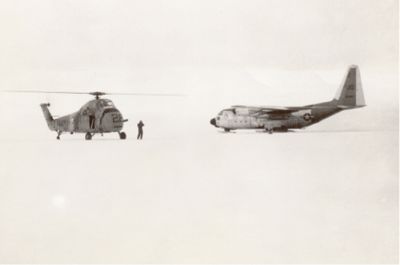 As the 130 lands and taxis after arriving from Christchurch, one of the squadron helicopters (a HUS-1A) is standing by in case of emergency (JS) (official photo caption). COMMENTARYThe above article was written in Washington, DC before the 1961 winter was over. Accordingly, it was based on message traffic from Antarctica and accounts of those on board the flight. Nowadays, winter medevacs of one sort or another have been happening so often that they aren't news items any more. But in 1961 this was a completely new and untried experiment. In 1961 when Kuperov fell ill, no aircraft had previously flown in during the winter months. The preparations took awhile, with Kuperov's condition changing frequently for the better or worse as described above. The aircraft had to be readied, manned, and flown to Christchurch. A picket ship (the Staten Island) had to be positioned at 60°S to provide for communications, weather reporting, navigation, and emergency SAR readiness, since satellite comms and met data was still a thing of the future. In McMurdo, the public works crew had to level out a makeshift runway north of Observation Hill running parallel to Scott Base. This took some doing as Williams Field had mostly gone to sea in an earlier storm and the existing ice would not hold a C-130. When the time came for the medevac aircraft to arrive, it had to come into McMurdo using an emergency seaplane approach, that is, dropping 10-20 feet at a time leveling, and dropping more. GCA had been hurriedly installed. The weather was not the best as it was almost a whiteout condition, that is, no shadows allowing depth perception; as can be seen from the above photo. The makeshift runway was lined with barrels and kerosene pots. What happened afterward? Was he really sick? Some people may know, but it is not recorded formally. Leonid Kuperov returned to the Soviet Union after essentially no known medical treatment in NZ, and disappeared from public view. Several bits of speculation have emerged from the winter 1961 Antarctic community (which then as now is a fertile breeding ground for rumors and conspiracy theory)...one thought was that Kuperov wasn't sick at all but because of some major world crisis between super powers that was going on at the time the Kremlin wanted him back home...and another was that he asked for asylum while in Christchurch, but was whisked away by his Soviet handlers before that could take place. The most recent story I've heard is that the whole thing was a Soviet test as to whether the Americans really could get one of their citizens out if necessary. If you have any comments or corrections to make, 45+ years on, please share! Acknowledgements: In addition to the references above, the DF-61 Task Force 43 cruisebook and the June 1961 Bulletin of the US Antarctic Projects Officer contained further discussion and photos. Several folks who were at McMurdo and Byrd in 1961 also furnished information and photos--many thanks to Bruce Raymond (who provided the photo captions), Don Walk, Phil Bradford, and Robert Woods. 2012 UPDATEIn November 2012 I heard from Denis Yurkov (Денис Юрков), Leonid Kuperov was his great-uncle. Leonid and his sister (Denis's grandmother) have passed away, but their sister was still alive. Denis read this story here and decided to ask Leonid's sister for details. She told the following story: after the medevac, Leonid had a medical checkup in Christchurch as described above, but no root cause for his sickness was found. Later, after he returned to the USSR, he was examined at hospitals in Moscow and St. Petersburg, but no sources of his sickness were revealed. But...soon after that he was on vacation at a Black Sea resort, and there he suffered from acute appendicitis, which turned into peritonitis. He was operated on there. His later years were spent in St. Petersburg, and Denis visited him there in 1987. |
